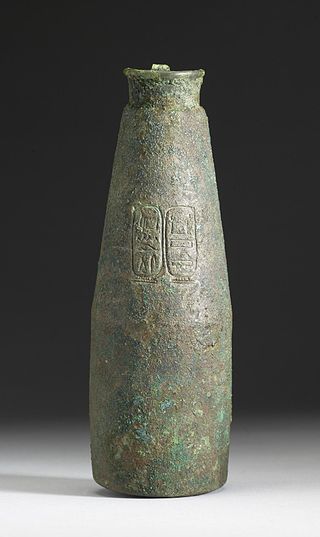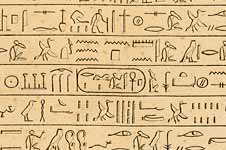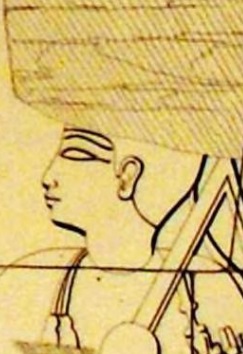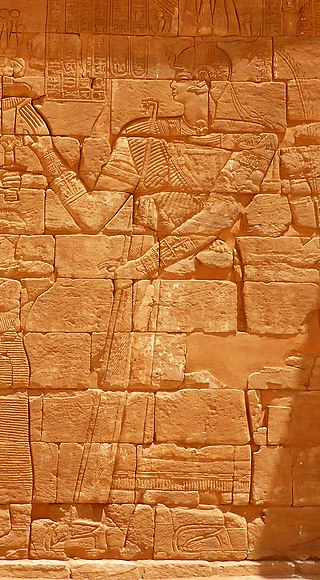Related Research Articles

The Meroitic language was spoken in Meroë during the Meroitic period and became extinct about 400 AD. It was written in two forms of the Meroitic alphabet: Meroitic Cursive, which was written with a stylus and was used for general record-keeping; and Meroitic Hieroglyphic, which was carved in stone or used for royal or religious documents. It is poorly understood, owing to the scarcity of bilingual texts.

Kashta was an 8th century BCE king of the Kushite Dynasty in ancient Nubia and the successor of Alara. His nomen k3š-t3 "of the land of Kush" is often translated directly as "The Kushite". He was succeeded by Piye, who would go on to conquer ancient Egypt and establish the Twenty-Fifth Dynasty there.

Apedemak or Apademak was a major deity in the ancient Nubian and Kushite pantheon. Often depicted as a figure with a male human torso and a lion head, Apedemak was a war god worshiped by the Meroitic peoples inhabiting Kush. He has no Egyptian counterpart. As a war god, Apedemak came to symbolize martial power, military conquest, and empire. Apedemak is also closely associated with Amun, the state-sponsored Egyptian deity during the preceding Napatan period, and is assumed to hold an equal level of importance.

Alara was a King of Kush, who is generally regarded as the founder of the Napatan royal dynasty by his 25th Dynasty Kushite successors and was the first recorded prince of Kush. He unified all of Upper Nubia from Meroë to the Third Cataract and is possibly attested at the Temple of Amun at Kawa. Alara also established Napata as the religious capital of Kush. Alara himself was not a 25th dynasty Kushite king since he never controlled any region of Egypt during his reign compared to his two immediate successors: Kashta and Piye respectively. Nubian literature credits him with a substantial reign since future Nubian kings requested that they might enjoy a reign as long as Alara's. His memory was also central to the origin myth of the Kushite kingdom, which was embellished with new elements over time. Alara was a deeply revered figure in Nubian culture and the first Kushite king whose name came down to scholars.

Natakamani, also called Aqrakamani, was a king of Kush who reigned from Meroë in the middle of the 1st century CE. He ruled as co-regent together with his mother Amanitore. Natakamani is the best attested ruler of the Meroitic period. He and Amanitore may have been contemporaries of the Roman emperor Nero.

Amanishakheto was a queen regnant (kandake) of Kush who reigned in the early 1st century AD. In Meroitic hieroglyphs her name is written "Amanikasheto". In Meroitic cursive she is referred to as Amaniskheto qor kd(ke) which means Amanishakheto, Qore and Kandake.

Teqorideamani was the King of Kush who was ruling in AD 253. His reign may be dated from 245/246 to sometime after 265/266. His throne name, attested in Egyptian hieroglyphics, was Ḫpr-kꜣ-Rꜥ, meaning "Ra is one whose ka came into being". Rendered in Meroitic, it is Natakamani or Ariteñyesebokhe. His given name, Teqorideamani, is attested in Meroitic hieroglyphs in his tomb inscription.

Kandake, kadake or kentake, often Latinised as Candace, was the Meroitic term for the sister of the king of Kush who, due to the matrilineal succession, would bear the next heir, making her a queen mother. She had her own court, probably acted as a landholder and held a prominent secular role as regent. Contemporary Greek and Roman sources treated it, incorrectly, as a name. The name Candace is derived from the way the word is used in the New Testament.

Senkamanisken was a Kushite King who ruled from 640 to 620 BC at Napata. He used royal titles based on those of the ancient Egyptian pharaohs.

Ad-Dakka was a place in Lower Nubia. It is the site of the Greco-Roman Temple of Dakka, dedicated to Thoth, the god of wisdom in the ancient Egyptian pantheon. The temple was initially a small one-room shrine or chapel, first begun in the 3rd century BC by a Meroitic king named Arqamani in collaboration with Ptolemy IV who added an antechamber and a gate structure. Ptolemy IX "subsequently enlarged the temple by adding a pronaos with two rows of probably three columns." During the Roman period, the Emperors Augustus and Tiberius further enlarged the structure with "the addition, at the rear, of a second sanctuary as well as inner and outer enclosure walls with a large pylon. The sanctuary contained a granite naos." The Temple of Dakka was transformed into a temple fortress by the Romans and surrounded by a stone wall, 270 by 444 metres long, with an entrance along the Nile.

Nubia is a region along the Nile river encompassing the area between the first cataract of the Nile and the confluence of the Blue and White Niles, or more strictly, Al Dabbah. It was the seat of one of the earliest civilizations of ancient Africa, the Kerma culture, which lasted from around 2500 BC until its conquest by the New Kingdom of Egypt under Pharaoh Thutmose I around 1500 BC, whose heirs ruled most of Nubia for the next 400 years. Nubia was home to several empires, most prominently the Kingdom of Kush, which conquered Egypt in the eighth century BC during the reign of Piye and ruled the country as its 25th Dynasty.

The Kingdom of Kush, also known as the Kushite Empire, or simply Kush, was an ancient kingdom in Nubia, centered along the Nile Valley in what is now northern Sudan and southern Egypt.

Arqamani was a Kushite King of Meroë dating from the late 3rd to early 2nd century BCE.

Arnekhamani was a Nubian king of the Kushite Kingdom in the third century BC. The king is mainly known from his building activity at the Musawwarat es-Sufra temple complex. The main temple complex at this place was built by Arnekhamani, but was never finished. Most likely the king died before completing the temples.

The Triakontaschoinos, Latinized as Triacontaschoenus, was a geographical and administrative term used in the Greco-Roman world for the part of Lower Nubia between the First and Second Cataracts of the Nile, which formed a buffer zone between Egypt and later Rome on the one hand and Meroë on the other hand. The northern part of this area, stretching from the First Cataract south to Maharraqa, was known as the Dodekaschoinos or Dodecaschoenus. In the Ptolemaic and Roman periods the Dodekaschoinos was often annexed to Egypt or controlled from it, and the rest of the Triakontaschoinos sometimes was as well.

Sebiumeker was a major supreme god of procreation and fertility in Nubian mythology who was primarily worshipped in Meroe, Kush, in present-day Sudan. He is sometimes thought of as a guardian of gateways as his statues are sometimes found near doorways. He has many similarities with Atum, but has Nubian characteristics, and is also considered the god of agriculture.
Yesebokheamani was the king (qore) of Kush in the late 3rd or early 4th century AD. He seems to have been the king who took control of the Dodecaschoenus after the Roman withdrawal in 298. This enabled him to make a personal visit to the temple of Isis at Philae.

Nubia is a region along the Nile river encompassing the area between the first cataract of the Nile as well as the confluence of the blue and white Niles or, more strictly, Al Dabbah. Nubia was the seat of several civilizations of ancient Africa, including the Kerma culture, the kingdom of Kush, Nobatia, Makuria and Alodia.
The reign of Amanitore was considered one of the most prosperous times of the Meroitic period. She ruled alongside Natakamani, who was either her husband or her son. The success of the two rulers is evident through their work towards the building, restoration, and expansion of many temples throughout Nubia. The temples that can be accredited to the work of the two include: the Temple of Apedemak, the Amun temple B500 at Napata, the Amun temple at Meroe, the Amun Temples of Naqa and Amara, the Isis temple at Wad ben Naqa, and the Meroitic palace B1500 at Napata.
References
Citations
- ↑ Török 1997, p. 471.
- ↑ Török 1997, pp. 471–472.
- ↑ Török 2009, p. 457.
- ↑ Török 1997, p. 472.
- 1 2 Török 2009, pp. 457–458.
- ↑ Török 2009, pp. 458–459.
- 1 2 3 4 5 6 Török 2009, p. 456.
- 1 2 Török 2009, p. 458.
- ↑ Török 2009, p. 459.
- ↑ Török 2009, pp. 459–460.
- ↑ Török 2009, pp. 460–461.
- 1 2 Török 2009, p. 461.
- ↑ Török 2009, pp. 461–463.
- ↑ Török 2009, p. 463.
- ↑ Török 2009, pp. 463–464.
- ↑ Török 2012, p. 759.
- ↑ Török 2009, p. 464.
Works cited
- Török, László (1997). The Kingdom of Kush: Handbook of the Napatan-Meroitic Civilization. Leiden, New York, Köln: Brill. ISBN 90-04-10448-8.
- Török, László (2009). Between Two Worlds: The Frontier Region Between Ancient Nubia and Egypt, 3700 BC-AD 500. Leiden, New York, Köln: Brill. ISBN 978-90-04-17197-8.
- Török, László (2012). "Between Egypt and Meroitic Nubia". In Riggs, Christina (ed.). The Oxford Handbook of Roman Egypt. Oxford: Oxford University Press. pp. 749–762. ISBN 978-0-19-957145-1.
- [1]